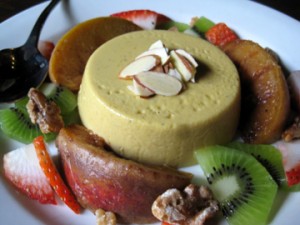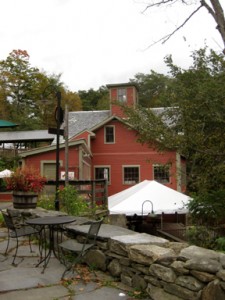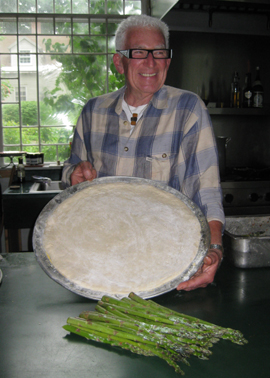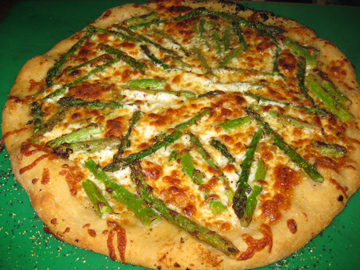

The Old Mill
2 tablespoons cold water
2-1/2 cups heavy cream (Max uses Mapleline)
3/4 cup sugar
2 teaspoons vanilla
1 cup mashed, pureed sweet potatoes
2 chai-flavored tea bags (such as Celestial Seasonings)
3/4 cup crème fraîche



The Old Mill


Michael Collins is ready to start making pizza.
The Green Emporium in Colrain, Massachusetts, is a happy, busy place these days. Chef Michael Collins and his partner, manager Pacifico “Tony” Palumbo, have achieved something few restaurateurs (or even non-restaurateurs) have managed. They have successfully reinvented themselves—or at any rate their restaurant.
More than a decade ago the pair opened the Green Emporium as a high-end eatery. Michael used his culinary training and imagination to transform as many local ingredients as possible into “country fusion” cuisine. Tony, who is an artist, decorated the restaurant (a former church) with colorful neon art and paintings. The pair acted like true hosts rather than just proprietors of the restaurant.
To make the place more fun they offered jazz on many weekends. (In the interest of full disclosure I should add that they frequently featured a chanteuse named Tinky Weisblat.) The Green Emporium began to attract diners from all over New England.
The menu and ambiance drew notice from the Boston Globe and Yankee, not to mention local papers. Nevertheless, keeping the place going proved a challenge—particularly in the winter, when even lovers of great food were reluctant to navigate the steep hill from Greenfield, our county seat, to quiet Colrain.
Michael and Tony, both in their 60s, longed for a simpler life. “I got burned out being behind the line and doing everything,” Michael told me recently.
They put the lovely old church on the market but ran straight into the real-estate crisis. For a couple of years the building sat empty, and its owners suffered financially.
According to Michael, it was Tony who came up with the idea of reopening the restaurant as a pizzeria. “With the new economy,” the chef said wryly, “the only thing I could do was try.”
He visited myriad pizza parlors to determine which features he liked best in a pizza. He decided he wanted a hand-stretched crust, “because that’s what gives you the chewy and the crispy.”
Michael worked at creating his own crust for quite a while. “I think it was six months,” he told me with a smile. “We were constantly having pizza.” Using tiles in his oven at home, he finally came up with a crust that satisfied his palate.
Michael is not giving out the recipe for his crust. He advises home cooks to purchase pre-made pizza dough from a grocery store but cautions them to let it rest a bit before stretching it. He did reveal that his crust includes extra-virgin olive oil, a touch of organic raw sugar, baker’s yeast, and sea salt. He emphasized the importance of good Colrain spring water to the final product.
“Toppings were not a problem,” he added with a laugh, explaining that ideas for novel pizza toppings come to him all the time.
Past and current favorites have included an apple and cider pizza; pizzas featuring local mushrooms from New England Wild Edibles and goat cheese from Hillman Farm; and now that summer is here a classic Pizza Margarita with fresh tomatoes and mozzarella. When new potatoes come in Michael intends to pair them in pizza with extra virgin olive oil, rosemary, and gorgonzola.
The restaurant reopened in the fall of 2008 as Mike and Tony’s Pizzeria at the Green Emporium and became an immediate success. Michael leaves the manning of the giant pizza oven (which takes three hours to preheat) to young assistants. This leaves him free to work on soups, salads, his signature “Mussels Emporium,” and new pizza toppings.
“People know it’s still the Green Emporium so they expect a little something extra,” Michael Collins said with a twinkle in his eye.
The Green Emporium is open Thursday through Sunday evenings for diners or those who wish to take food home. If customers give him notice, Michael can prepare a gluten-free pizza.
Here is a recipe for one of his signature pizzas, one that represents the extended spring diners in New England enjoyed this year—and also the spring that the restaurant has enjoyed in its rebirth. It features my favorite vegetable!
Colrain Spring Pizza
Ingredients:
1/2 to 1 pound asparagus (to taste)
1/2 cup extra-virgin olive oil plus 1/4 cup later
1/4 teaspoon red pepper flakes
1/2 cup grated Parmesan or Romano cheese (plus 3 to 4 tablespoons later)
1 teaspoon lime or lemon zest
1 teaspoon lime or lemon juice
1/4 teaspoon sea salt
1-1/2 pounds pizza dough
1 heaping cup shredded mozzarella cheese, plus 1/4 cup later
a sprinkling of cornmeal
small pieces of cooked chicken to taste (optional)
Instructions:
Trim the bottoms off the asparagus spears, and cut them in thirds. Combine the 1/2 cup oil, red pepper flakes, 1/2 cup grated cheese, zest, juice, and sea salt. Toss in the cut asparagus spears, and let the mixture sit overnight.
The next day bring the pizza dough to room temperature and preheat the oven to 500 degrees. Place the dough on a round pan on which you have sprinkled cornmeal. Gently stretch the dough to a 16-inch diameter.
Using a brush or spatula, brush oil around the outer edge of the circle of dough; it should go from the very edge in about 1-1/2 to 2 inches. Sprinkle the heaping cup of mozzarella cheese evenly over the dough.
Place the marinated asparagus spears around the circle to resemble spokes of a wheel or a pinwheel design. The idea, according to Michael Collins, is that “each piece [of pizza] will get more than its share of asparagus. You want it a little bit rustique.”
Sprinkle the remaining mozzarella on top, “cementing the asparagus in.” Follow with the remaining grated cheese.
“You want to add chicken? You can add chicken,” Michael says of this stage.
Bake the pizza for 10 to 12 minutes, or until it is crispy and bubbly. (Readers who have made pizza with tomato sauce will be surprised at how quickly this dryer pizza bakes, Michael notes.)
Let the pizza rest for a few minutes before eating and slicing. Serves 8 as a main course or 16 as a first course.

The kitchen at the Blue Heron Restaurant in Sunderland, Massachusetts, is a very busy place and a very happy one. Music plays as several cooks work in different sections of the room, creating tantalizing smells as they toast spices, glaze cakes, or efficiently peel and combine potatoes and parsnips. I spent a couple of hours there recently with Chef Deborah Snow—and I couldn’t help smiling almost continuously.
Deborah spent our time showing me how to make a dish that reflected her signature focus on local food. She took advantage of the fall harvest to make butternut-squash ravioli, a deceptively simple Tuscan dish that is a favorite with Blue Heron customers. “I’ve gotten a lot of marriage proposals with this,” she said of the ravioli. She served it with a devastatingly rich brown-butter sauce.
By using premade dumpling wrappers for the ravioli Deborah rendered them simple for home cooks. I helped her assemble the ravioli (when put together they look a bit like fried eggs) and was impressed at how easy they were to create.
The biggest trick in the recipe is the butter sauce, which can be a little temperamental; the butter should look brown and taste toasted but not burned. The other trick for the home cook will be timing. Deborah made the brown-butter sauce and the ravioli more or less simultaneously because she knows instinctively when to check on each pot.
Less experienced cooks should probably shape the ravioli and then begin browning the butter in order to keep a careful eye on the sauce. The ravioli can easily be boiled after the sauce is complete; these little pieces of pasta don’t take very long to cook.
I followed this method at home. My dish was almost as delicious as Deborah’s—if a bit less beautiful.
To learn more about the Blue Heron, visit its web site, http://www.blueherondining.com. Meanwhile, here is the recipe for the ravioli, kindness of Deborah Snow.
Blue Heron Butternut Squash Ravioli
Ingredients:
for the ravioli:
1 medium butternut squash
extra-virgin olive oil, kosher salt, and pepper to taste for roasting
1 cup shredded or grated Parmegiano-Reggiano cheese
1/4 cup extra-virgin olive oil
1/2 whole nutmeg, freshly grated
kosher salt to taste (start with 1 teaspoon)
freshly ground pepper to taste (start with 1/2 teaspoon)
72 round 3-inch wheat dumpling wrappers (available from Asian markets)
1 egg
additional cheese and several small sage leaves for garnish
for the sauce:
1 pound unsalted butter
10 fresh sage leaves, plus 5 more leaves later, chopped
1-1/4 cups white wine
1-1/2 cups heavy cream
Instructions:
for the ravioli:
Preheat the oven to 375 degrees. Cut the squash in half lengthwise, remove the seeds and gunk, and rub a little oil, salt, and pepper on the flesh. Roast the squash until it is soft enough to scoop out easily. Begin roasting with the flesh side down in your pan, and turn the squash over after about 20 minutes. Snow explains that the length of time it will take to roast the squash to the desired consistency depends on the strength of your oven. I would start checking the squash to see whether it is tender after about 30 minutes. It can take much longer than this, however, especially with young squash!
Scoop the squash out of its skin, and use a potato masher to blend in the cheese, olive oil, nutmeg, salt and pepper. (Do NOT use a food processor.)
Place half of the dumpling wrappers (36) on a work surface. Spoon a generous tablespoon of the squash mixture into the middle of each wrapper. You will probably have leftover squash, which is delicious by itself as a side dish.
Beat the egg with a splash of water; then use a pastry brush to brush the edges of the dumpling wrappers with the egg mixture. Place another wrapper on top, and use your fingertips to seal the edges of your ravioli, trying to push out any air bubbles that have formed.
Put a large pot of water (at least 2 quarts) on the stove, and add 2 teaspoons of salt. When the water comes to a boil, place the ravioli gently in the boiling water. Return the water to the boil, and cook for 3 to 4 minutes longer, stirring gently (particularly in the beginning) to keep the ravioli separated. Remove the ravioli gently from the water with a slotted spoon, place them in 6 individual pasta dishes, and ladle brown-butter sauce over all. Top with additional cheese and sage leaves. Serves 6 with 6 ravioli apiece.
for the sauce:
Place the entire pound of butter in a medium saucepan over medium heat, and bring it to a boil. Cook it slowly, monitoring its progress to keep it from burning. When it begins to turn brown around the edges, it is almost finished cooking. Skim off (and discard) any fuzz on top. The cooking process for the butter takes about 10 minutes on Deborah Snow’s very hot stove; it will probably take longer on a home range.
The butter will soon develop a rich caramel color. Turn off the heat, and add the first 10 chopped sage leaves. The butter will bubble up in response. Let it rest for a couple of minutes.
When the butter has cooled a bit, spoon out the milk solids and discard them; you will only need the liquid.
In a medium skillet, heat the wine until it is reduced by half. Whisk in the cream, and again let the liquid reduce by half. Throw in the additional chopped sage leaves while the sauce is reducing. When the sauce is nice and thick, whisk in the brown butter to taste. You may not need all of it, but you will need most of it.